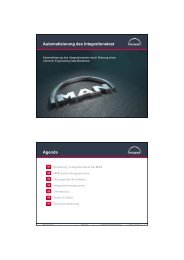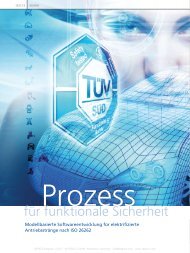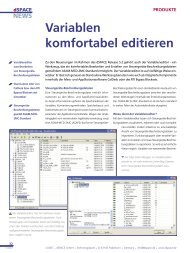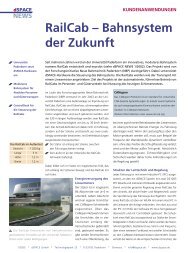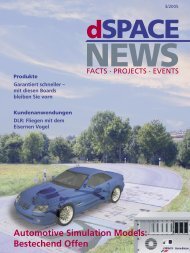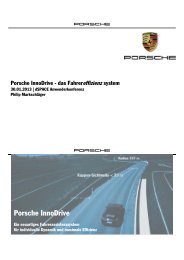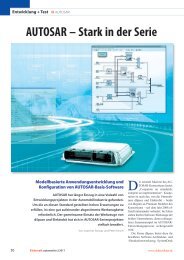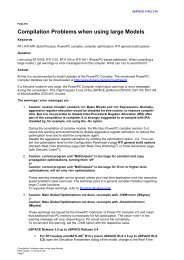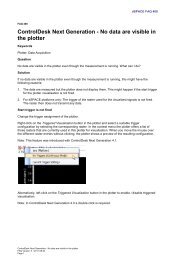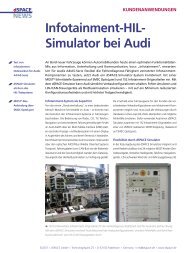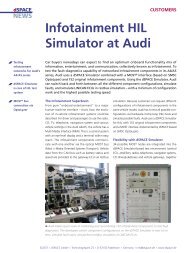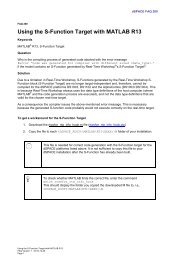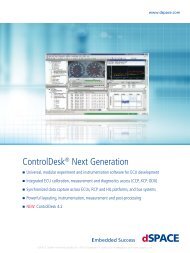magazinE - dSPACE
magazinE - dSPACE
magazinE - dSPACE
You also want an ePaper? Increase the reach of your titles
YUMPU automatically turns print PDFs into web optimized ePapers that Google loves.
pAGe 12 AUTOSAR FUNCTION DeveLOpMeNT<br />
First the SWC was created in the<br />
Data Dictionary, then the appropriate<br />
AUTOSAR blocks were inserted<br />
in the model (fig. 6). Finally, the<br />
XML file (SWC description file)<br />
created during code generation was<br />
loaded to the SWC database. The<br />
interface can now be maintained in<br />
the database.<br />
The modeled functionality (behavior<br />
model) was migrated in its entirety<br />
and with no modifications; only the<br />
model interface had to be adapted<br />
to the standard (fig. 7).<br />
aUTOSaR Tool Chain<br />
An existing tool chain was extended<br />
for developing AUTOSARcompliant<br />
vehicle functions (fig. 8). The<br />
common object pool for storing<br />
AUTOSAR interfaces and SWC<br />
descriptions is a major component<br />
of the development environment.<br />
It was implemented as an extension<br />
to an existing database application<br />
used for creating communication<br />
matrices. The pool not only contains<br />
AUTOSAR modeling elements; in it,<br />
parameters and NVRAM variables<br />
can also be described and given<br />
values. Because of its similarity to<br />
the communication matrix,<br />
AUTOSAR interfaces can be generated<br />
elegantly from the data in<br />
the communication matrix and sub<br />
Fig. 6: The functions are modeled with<br />
TargetLink’s AUTOSAR blocks.<br />
sequently updated. The tried and<br />
tested release concept used for communication<br />
matrix development can<br />
also continue to be used.<br />
The SWC descriptions can be<br />
imported and exported via the<br />
AUTOSAR interchange formats. This<br />
supports the connection to the Data<br />
Dictionary and to system architecture<br />
tools. The modelbased development<br />
of AUTOSARcompliant<br />
function models is supported by<br />
modelintheloop (MIL) and softwareintheloop<br />
(SIL) tests, both<br />
integrated in the development<br />
environment. Finally, AUTOSARcompliant<br />
production code together<br />
with a consistent AUTOSAR SWC<br />
description file is generated.<br />
The system architecture tools are<br />
used to network the SWCs. This is<br />
usually done in graphical editors,<br />
which provide better visualization<br />
than purely formbased database<br />
applications. The system architecture<br />
tool is now being used to map the<br />
nonlocal data elements to network<br />
signals. The resulting AUTOSAR<br />
system template is used for ECU<br />
integration at the supplier.<br />
Conclusions and Outlook<br />
AUTOSAR is answering a longstanding<br />
need to standardize the<br />
description formats and interfaces<br />
Fig. 7: Modeled runnable with<br />
appropriate interface blocks after<br />
AUTOSAR migration.<br />
for modelbased function development.<br />
The typesafe AUTOSAR<br />
descriptions make it possible to ensure<br />
consistency between separately<br />
developed function models at the<br />
very early stage in the development<br />
process when we as the OEM hand<br />
over the function models to the ECU<br />
supplier. The expectation is that this<br />
will make the function integration<br />
by the supplier much more efficient.<br />
Coordination meetings held<br />
between the OEM and the supplier<br />
to discuss software architecture are<br />
considerably more productive<br />
because both sides can use terms<br />
that are standardized by AUTOSAR.<br />
The current necessity of using two<br />
development tools (for modeling<br />
behavior and for describing<br />
interfaces) in developing AUTOSAR<br />
compliant function networks poses<br />
new challenges, as each system has<br />
to be divided into manageable and<br />
logically useful software components.<br />
In the future, the transitions<br />
between different modeling tools,<br />
often from different vendors, will<br />
have to be made more efficient to<br />
ensure a ‘round trip’. Moreover, the<br />
current division of AUTOSAR<br />
development environments, into<br />
tools for architecture modeling and<br />
system integration and tools for<br />
behavior modeling with their own



